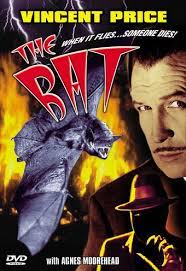
Mystery writer Cornelia Van Gorder (Agnes Moorehead) rents a summer home called The Oaks from a bank president named John Fleming (Harvey Stephens). On a hunting trip with his friend Doctor Malcolm Wells (Vincent Price), he confesses to stealing more than a million dollars in negotiable securities. He will split the money with the Doctor in return for him faking his death. Wells kills him instead and reports his death an accident.
The town is being terrorized by a mysterious murderer they call the Bat, supposedly a man with no face who rips out the throats of women at night with steel claws. Cornelia’s assistant Lizzie Allen (Lenita Lane) reports that all the servants except the chauffeur have quit in fear. As they lock up the house that night, Lizzie sees the Bat’s steel claws reaching in through an unlocked window. Cornelia calls the police, who send officers. The Bat breaks into the house and releases a real bat, which bites Lizzie. As Lizzie is afraid of rabies, they call Doctor Wells.
Wells is in his lab, experimenting on bats. Lieutenant Andy Anderson (Gavin Gordon), Chief of Detectives, is watching through a window. When Wells leaves for The Oaks, the detective breaks into the lab and searches it, obviously suspecting the Doctor’s interest in bats. Wells arrives at the house, checks Lizzie’s wound and catches the bat. Anderson arrives soon and says an officer will watch the house. Are you with me so far?
Cornelia is visited by Wells, Dale Bailey (Elaine Edwards) and Judy Hollander (Darla Hood). Dale’s husband Victor (Mike Steele) is a bank clerk and the prime suspect in the robbery because Fleming had framed him, and Judy, who also works at the bank, is a witness for his defense. While Lieutenant Anderson is visiting Mark Fleming (John Bryant), nephew and heir to John Fleming, Cornelia has Dale call him about a possible floorplan of the house and Dale promises to check it out. They think the money is hidden there and that is what the Bat is after. New servants have been hired and the chauffeur, Warner (John Sutton), is now promoted to butler. Still with me?
During Dinner, Mark Fleming sneaks into the house to examine the blueprints. The Bat kills him and steals the blueprints. Detective Anderson and Doctor Wells (also town coroner) arrive to investigate. The detective tells the women to lock themselves in their rooms. Of course, they don’t. Lieutenant Anderson goes into the woods with a flashlight, trailed by Warner. The Bat enters the house, cuts the phone lines, and goes to the third floor, where he chisels a hole in the wall. Dale and Judy go to investigate the noise. The Bat kills Judy and escapes. Lieutenant Anderson returns and accuses Warner, whom he knows from a robbery investigation in Chicago. Perhaps the butler did it. Warner says he was acquitted. Doctor Wells comes into the house, saying that he had an accident with the car, and Anderson suspects him too. Wait! There’s more.
Cornelia discovers a secret room behind the wall that was being chiselled. She accidentally traps herself in an airless passage but is freed by Detective Davenport (Robert B. Williams). The Bat comes to kill Wells in his lab and Wells pulls a gun and taunts the killer, whom Wells seems to know. Wells tells the Bat that he knows where the money is and will collect it as soon as the Bat is dead. They struggle and Wells is killed. The Bat leaves a suicide note, confessing that Wells was the Bat. Then he goes to the house and sets the garage on fire. Cornelia realizes that the fire is to get everyone out of the house, but she tells Dale, Lizzie, and Davenport to hide. The Bat shoots Davenport and is about to kill the women when Warner shoots him down. Cornelia unmasks him. The Bat is…
This very complex story, with all its red herrings, was directed by playwright Crane Wilbur and was the fourth version based on the 1908 novel The Circular Staircase by Mary Roberts Rinehart, and the 1920 play called The Bat which she adapted with Avery Hopwood. The rights to the story were purchased from Mary Pickford, who produced the 1926 film with the other heads of United Artists—Douglas Fairbanks, Charles Chaplin, and D,W, Griffith. The film received mixed reviews and was unfavorably compared with the earlier versions. Vincent Price was disappointed in the film. He was terrified by the play as a child and found this a bit tame.
It was released with The Mummy (1959). One of the houseguests was played by Darla Hood of the Our Gang Comedies, her last movie role. The music was a combination of classical orchestra and steel guitar rock and roll by Alvino Rey. I don’t think it was as bad as the reviews suggest. Agnes Moorehead was quite engaging, I thought, and she and her assistant were sometimes funny. It could have been darker and more brooding in that big old house and that would have made the Bat more horrific. Vincent Price was a charming cold killer but he was kind of wasted in the film, with only a few scenes. The whole thing felt like an episode of Murder She Wrote.
